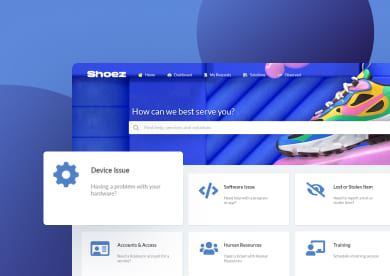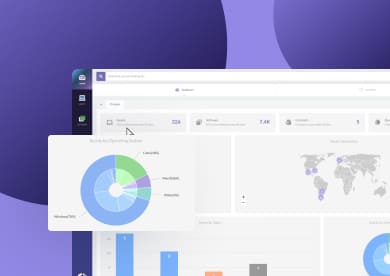IT audit software helps organizations evaluate and improve their IT controls, compliance, and security practices. These tools automate many parts of the audit process, so teams can spot issues faster and reduce manual effort.
But with so many options available, choosing the right one can be tricky. That’s why we combined our hands-on experience with in-depth market research to compile this list of the top IT audit software tools for 2025 — helping you compare features and choose the solution that best fits your needs.
Let’s get started.
Methodology
Before diving in, it’s worth mentioning that InvGate develops and markets both IT Service Management (ITSM) and IT Asset Management (ITAM) solutions, so we’re part of the same ecosystem covered in this article.
While some of the tools featured here compete directly with our products, our goal is to provide reliable, transparent, and useful insights to help you make an informed decision.
Our research combines publicly available data — including vendor websites, official documentation, user feedback from trusted review platforms such as Gartner Peer Insights, G2, and Capterra, as well as analyst reports and, when possible, hands-on testing or live demos. Each software option was assessed considering its main features, pricing (when disclosed), integrations, ease of use, and quality of support.
All information is current as of October 2025, and we periodically update our comparisons to reflect new releases and market changes.
Top 10 IT audit software for 2025
Below you’ll find our curated list of the top 10 IT audit software solutions, compiled from official vendor data and independent market research.
| Tool | Type / Focus | Gartner rating | Pricing model |
| InvGate Asset Management | ITAM with IT audit support | 4.8 | Subscription-based, starting at $0.21 per node/month. |
| Netwrix Auditor | IT audit / security & compliance | 4.7 | No public pricing. Contact vendor for quote. |
| Archer Audit Management | Enterprise Audit Management (GRC) | 4.2 | Subscription-based, varies by users, modules, deployment. |
| MetricStream Internal Audit Management | Enterprise audit / GRC | 3.9 | Subscription-based, varies by users and deployment. |
| MasterControl Audit (Quality Excellence) | QMS audit / compliance | 4.4 | Named-user license; tiered packages (Basic, Standard, Complete). |
| AuditBoard Connected Risk Platform | Cloud GRC / audit, risk & compliance | 4.5 | Subscription-based; no public pricing. Contact vendor for quote. |
| Hyperproof | Compliance & IT risk | 4.7 | Subscription-based; no public pricing. Contact vendor for quote. |
| Pathlock Cloud Platform | ERP / access control audit | 4.6 | SaaS or on-premises; no public pricing. Contact vendor. |
| SAP Audit Management | Internal audit (enterprise) | 4.3 | Subscription-based (per user or license tier). |
| Onspring Internal Audit & Assurance | GRC platform module | 4.5 | Multiple models (by users, by products, hybrid); Bronze–Platinum tiers. |
Data accurate as of October 2025. Sources: official vendor documentation and public review platforms.
#1. InvGate Asset Management

InvGate Asset Management is a comprehensive IT Asset Management solution with powerful capabilities to support IT audits and compliance processes.
It helps organizations centralize their asset inventory, monitor software usage, and generate audit-ready reports with minimal effort, making it an essential tool for IT teams looking to reduce manual work and stay ahead of regulatory requirements.
Trusted by organizations like KPMG, NASA, PwC, Motorola, Allianz, Arcos Dorados, Collins Aerospace, and Peoples Bank, InvGate provides the visibility, control, and automation needed to simplify audits and strengthen IT governance.
InvGate Asset Management features for IT auditing
- Centralized IT asset inventory – Automatically discovers hardware and software across the organization to create a reliable, up-to-date inventory for audit preparation.
- Software compliance tracking – Detects unauthorized or unused software installations to ensure compliance with licensing agreements.
- Custom dashboards and audit reports – Build dashboards and export detailed reports on asset status, software usage, health, and compliance.
- Automated health rules – Define policies to flag non-compliant or risky assets (e.g., outdated systems, missing patches).
- Lifecycle and change history – Track asset changes, ownership transfers, and usage logs for traceability and internal control.
- Integrations – Syncs with tools like Active Directory, Entra ID, and Okta to ensure consistency across access records and asset ownership.
InvGate Asset Management reviews and comments
- Gartner Peer Insights: 4.8 out of 5 stars.
- G2: 4.7 out of 5 stars.
- Capterra: 4.4 out of 5 stars.
InvGate Asset Management pricing
InvGate uses a node-based subscription model, with three pricing tiers:
- Starter Plan – $0.21 per node/month (minimum $1,250/year), up to 500 nodes.
- Pro Plan – $0.38 per node/month, billed annually, for 501–10,000 nodes.
- Enterprise Plan – Custom pricing for larger or specialized environments.
A 30-day free trial is available with no credit card required, and organizations can choose between cloud or on-premise deployment based on their infrastructure and compliance needs.
#2: Netwrix Auditor
 According to its own product page, Netwrix® Auditor is an IT audit software that allows teams to identify risks, detect threats, and automate compliance. According to Gartner Peer Insights, the product enables organizations to identify security gaps, track user activity, and detect suspicious behaviors in time to respond to potential threats.
According to its own product page, Netwrix® Auditor is an IT audit software that allows teams to identify risks, detect threats, and automate compliance. According to Gartner Peer Insights, the product enables organizations to identify security gaps, track user activity, and detect suspicious behaviors in time to respond to potential threats.
Within the broader IT audit landscape, it focuses specifically on security and compliance auditing. This makes it particularly useful for teams responsible for data protection, access control, and regulatory compliance.
Netwrix Auditor features
According to the vendor’s product page, these are some of the main capabilities included in Netwrix Auditor:
- Track all activity and get real-time alerts - Monitor every change, login, or access attempt and receive near real-time notifications customized to your needs.
- Run risk assessments and detect threats - Identify security gaps such as excessive permissions and take corrective actions to reduce your organization’s attack surface.
- Delegate Access Management - Enforce the principle of least privilege while easing the workload on IT teams. Allow business users to make access requests directly to data owners.
- Accelerate incident investigation - Access all the necessary information in just a few clicks, thanks to an intuitive search feature that simplifies root cause analysis and evidence gathering.
Netwrix Auditor ratings
These are the ratings from well-known review platforms for this solution:
- Gartner Peer Insights: 4.7 out of 5 stars.
- G2: 4.4 out of 5 stars.
- Capterra: 4.5 out of 5 stars.
Netwrix Auditor pricing
Netwrix Auditor has not published fixed pricing information for this product or service. This is standard practice for many software vendors and service providers. To obtain current pricing details, please contact Netwrix directly.
#3: Archer Audit Management
 According to its official datasheet, Archer® Audit Management is a flexible, no-code configurable platform with a risk-based approach to Audit Management. It allows organizations to enhance control over audit lifecycles, improve governance, and integrate audit activities with risk and compliance functions.
According to its official datasheet, Archer® Audit Management is a flexible, no-code configurable platform with a risk-based approach to Audit Management. It allows organizations to enhance control over audit lifecycles, improve governance, and integrate audit activities with risk and compliance functions.
Within the broader IT audit landscape, its focus is on enterprise-level Audit Lifecycle Management rather than technical system monitoring, making it particularly suitable for internal audit, risk, and compliance teams that want to coordinate their assurance efforts.
Archer Audit Management features
According to the vendor’s datasheet, Archer Audit Management provides a single platform to orchestrate the complete audit process:
- Control the entire audit lifecycle – Manage audit planning, scoping, execution, and follow-up within one system.
- Integrate with risk and compliance functions – Share data and collaborate across teams to prioritize audit efforts based on business priorities.
- Centralize audit documentation – Store work papers, evidence, findings, and remediation actions in a unified repository for better visibility and coordination.
- Enable proactive decision-making – Adopt a risk-based audit approach to focus on the areas of highest importance and ensure management assurance controls are effective.
- Improve visibility and performance – Use real-time dashboards and analytics to monitor key risks, underperforming controls, and team productivity.
Archer Audit Management ratings
As of October 2025, these are the ratings from well-known review platforms for this solution:
- Gartner Peer Insights: 4.3 out of 5 stars.
- G2: No public rating currently available.
- Capterra: No public rating currently available.
Archer Audit Management pricing
According to Gartner Peer Insights, Archer Audit Management follows a subscription-based pricing model that varies depending on user count, selected modules, and organization size. The platform can be deployed either on-premises or in the cloud, with pricing adjusted accordingly.
However, Archer does not provide official pricing information on its website, so interested organizations should contact the vendor directly to obtain an accurate quote based on their specific needs and deployment model.
#4: MetricStream Internal Audit Management
 According to its product page, MetricStream® Internal Audit Management is a software that enables organizations to drive an agile internal audit program aligned with organizational goals and prepared for multi-dimensional risks.
According to its product page, MetricStream® Internal Audit Management is a software that enables organizations to drive an agile internal audit program aligned with organizational goals and prepared for multi-dimensional risks.
The audit methodology leverages next-generation technologies such as AI to significantly reduce the time spent sorting data to mine insights.
MetricStream Internal Audit Management features
According to the vendor’s product page, these are some of the main capabilities of MetricStream Internal Audit Management:
- Manage the audit universe – Define and maintain auditable entities, risks, and hierarchical structures within a centralized framework.
- Conduct risk-based audit planning – Assess and document risks, prioritize key areas, and plan audits using a unified risk framework.
- Enable collaboration and dynamic planning – Build and adjust audit plans collaboratively, allocating resources based on skills and availability.
- Streamline audit execution – Record findings, attach evidence, and track time through structured workpapers and time-tracking tools.
- Automate Issue Management with AI – Identify, classify, and track audit issues using AI/ML to recommend actions and monitor remediation progress.
MetricStream Internal Audit Management ratings
As of October 2025, these are the ratings from well-known review platforms for this solution:
- Gartner Peer Insights: 3.9 out of 5 stars (only 6 reviews).
- G2: 3.3 out of 5 stars (only 3 reviews).
- Capterra: No public average rating currently available.
MetricStream Internal Audit Management pricing
According to Gartner Peer Insights, MetricStream Internal Audit Management follows a subscription-based pricing model based on user count, selected modules, and deployment type (cloud or on-premises).
Official pricing is not published on the vendor’s website, so organizations must contact MetricStream for a custom quote.
#5: MasterControl Audit
According to information found in its own product page, MasterControl Audit™ is part of the MasterControl Quality Excellence™ platform, a cloud-based Quality Management System (QMS).
MasterControl Audit is a built-in module that enables teams to track, conduct and respond to audits while preserving data integrity.
MasterControl Audit Management features
According to the vendor’s datasheet, these are some of the main capabilities of MasterControl Audit Management:
- Guest Connect – Allow auditors to input responses directly into your MasterControl instance using a single-use account, eliminating email exchanges.
- Auditor responses – Enable auditees to respond to findings through action item forms or other quality event forms launched directly from the audit record.
- Audit templates – Define standards and criteria for each type of audit, creating reusable templates for consistent execution.
- Audit standard text – Maintain consistency by inserting predefined text, such as regulatory requirements, directly into audit documentation.
MasterControl Quality Excellence ratings
As of October 2025, these are the ratings from well-known review platforms for this solution:
- Gartner Peer Insights: 4.4 out of 5 stars.
- G2: 4.3 out of 5 stars.
- Capterra: 4.5 out of 5 stars.
MasterControl Quality Excellence pricing
According to information available on the vendor’s official website, MasterControl Quality Excellence offers multiple packages — Basic, Standard, and Complete — which can include modules such as Risk and Audit Management, Quality Event Management, and Supplier Management, among others.
The company follows a named-user license model and tailors each plan based on business size and needs.
#6: AuditBoard
 According to Capterra, AuditBoard® is a cloud-based platform for Audit, Risk, and Compliance Management. It enables organizations to manage internal audits, risk assessments, and compliance processes within a single environment.
According to Capterra, AuditBoard® is a cloud-based platform for Audit, Risk, and Compliance Management. It enables organizations to manage internal audits, risk assessments, and compliance processes within a single environment.
As described by Gartner Peer Insights, AuditBoard’s Connected Risk Platform is designed to elevate audit and risk teams, engage the broader business, and leverage risk as a strategic driver. At the center of the platform is a unified data core that centralizes risks, controls, policies, frameworks, and issues.
AuditBoard features
According to the information available on the product page, these are some of the main capabilities of AuditBoard Connected Risk Platform related to Audit Management:
- Centralize Audit Management – Manage the entire audit lifecycle from planning to reporting in one platform, enhanced with AI capabilities.
- Stay ahead of risk – Continuously align audits with evolving business risks through real-time insights and continuous auditing.
- Optimize testing and fieldwork – Automate repetitive audit tasks like sample selection and evidence tickmarking using AI-driven workflows.
- Streamline stakeholder communication – Manage document requests, follow-ups, and reporting in one place to simplify collaboration with stakeholders.
- Enable dynamic audit planning – Build and adjust audit plans based on changing risks and track coverage and results seamlessly.
AuditBoard Connected Risk Platform ratings
As of October 2025, these are the ratings from well-known review platforms for this solution:
- Gartner Peer Insights: 4.5 out of 5 stars.
- G2: 4.6 out of 5 stars.
- Capterra: 4.7 out of 5 stars.
AuditBoard pricing
AuditBoard does not provide official pricing information on its website. Organizations interested in the platform must contact the vendor directly and schedule a demo to obtain a customized quote based on their specific needs. There is no free trial.
#7: Hyperproof
 According to Gartner Peer Insights, Hyperproof is a cloud-based software platform designed to help organizations manage compliance operations and risk assessment processes.
According to Gartner Peer Insights, Hyperproof is a cloud-based software platform designed to help organizations manage compliance operations and risk assessment processes.
It streamlines workflows for evidence collection, requirement tracking, and audit readiness, integrating with third-party tools to automate data gathering and provide real-time visibility into controls and compliance status.
Hyperproof features
According to information found on the product page in G2, these are some of the main capabilities of Hyperproof:
- Get started quickly – Use prebuilt compliance templates to accelerate setup, or upload existing evidence to build toward full compliance.
- Centralize and automate evidence collection – Store all audit evidence in a secure, centralized platform with collaboration tools and automated reminders.
- Gain real-time feedback – Monitor audit preparedness and control effectiveness with up-to-date progress insights.
- Track compliance status – View and report the status of entire compliance programs or specific frameworks in real time.
Hyperproof ratings
As of October 2025, these are the ratings from well-known review platforms for Hyperproof:
#8: Pathlock
 According to information found on TrustRadius, the Pathlock Cloud Platform is a Risk and Compliance Management solution that integrates with ERP and other business applications to deliver continuous monitoring, analytics, and automated workflows.
According to information found on TrustRadius, the Pathlock Cloud Platform is a Risk and Compliance Management solution that integrates with ERP and other business applications to deliver continuous monitoring, analytics, and automated workflows.
The software helps organizations implement controls and maintain audit readiness across complex application environments. It’s available as a SaaS platform or as an on-premises deployment, offering flexible options for different enterprise needs.
Pathlock Cloud Platform features
According to the product datasheet available on TrustRadius, these are some of the main capabilities of Pathlock Cloud Platform:
- Integration with multiple business applications – Connects to ERP and enterprise systems through an open API with no in-app footprint, supporting both cloud and on-premises environments.
- Continuous monitoring and automated workflows – Detects and reacts to changes across systems in real time and automatically triggers relevant compliance workflows.
- Comprehensive cross-application risk visibility – Consolidates user identities, roles, and activities across all business systems to assess risks and enforce access controls.
- Purpose-built workflow engine – Provides configurable workflows for access, risk, and exception management, fully auditable and integrated with ticketing systems.
- Complete audit trail – Maintains full traceability of all actions, changes, and workflows to support audit readiness and internal control assurance.
Pathlock Cloud Platform ratings
As of October 2025, these are the ratings from well-known review platforms for this solution:
- Gartner Peer Insights: 4.6 out of 5 stars.
- G2: 4.5 out of 5 stars.
- Capterra: Not enough information available.
Pathlock Cloud Platform pricing
Official pricing information is not disclosed on the vendor’s website. Organizations must contact Pathlock directly to request a customized quote or schedule a demo tailored to their compliance and deployment needs.
#9: SAP Audit Management
 According to Gartner Peer Insights, SAP Audit Management is software designed to help organizations manage internal audit processes. It enables teams to plan, execute, document, and report on audit activities within a unified workflow.
According to Gartner Peer Insights, SAP Audit Management is software designed to help organizations manage internal audit processes. It enables teams to plan, execute, document, and report on audit activities within a unified workflow.
The platform supports risk assessment, audit planning, and resource allocation, helping organizations improve audit transparency, efficiency, and compliance with regulatory standards and internal policies.
SAP Audit Management features
According to information found on the vendor’s product page, these are some of the main capabilities of SAP Audit Management:
- Audit planning, Management, and performance – Simplify the creation, tracking, and management of audit issues with mobile documentation and drag-and-drop tools.
- Communication and monitoring of audit results – Accelerate issue resolution and visualize results with standardized templates and automated issue tracking.
- Simplified Audit Planning and Management – Use collaboration tools and intuitive interfaces to engage auditors, integrate with SAP Risk Management and SAP Process Control, and optimize scheduling and resource use.
- Consistent tracking and delivery of audit results – Improve issue reporting and generate enterprise-level audit insights from a central dashboard.
SAP Audit Management ratings
As of October 2025, these are the ratings from well-known review platforms for this solution:
- Gartner Peer Insights: 4.4 out of 5 stars
- G2: Not enough information available.
- Capterra: Not enough information available.
SAP Audit Management pricing
According to Gartner Peer Insights, SAP Audit Management follows a subscription-based pricing model, typically structured per user per month or based on license tiers. Pricing may vary depending on the number of users, deployment options, and additional features selected.
Detailed pricing is available upon request through a quotation process or by contacting SAP directly.
#10: Onspring Internal Audit & Assurance
 According to the Onspring Internal Audit & Assurance datasheet, this is not a standalone product but a module within the Onspring GRC Platform.
According to the Onspring Internal Audit & Assurance datasheet, this is not a standalone product but a module within the Onspring GRC Platform.
The platform connects audit, risk, and compliance functions in one no-code environment, allowing organizations to manage the entire audit lifecycle — from planning and execution to issue tracking and reporting — in a single, configurable solution (Audit & Assurance Onspring Brief).
The module is designed for internal audit teams that need flexibility, automation, and integration with other GRC processes such as Risk Management and compliance tracking (Audit & Assurance Onspring Brief).
Onspring Internal Audit & Assurance features
According to the vendor’s datasheet, these are five selected features relevant to internal audit operations (Audit & Assurance Onspring Brief):
- End-to-end Audit Management – Plan, execute, and monitor audit projects from a centralized workspace.
- Automated workflows – Route tasks, findings, and follow-ups automatically to streamline audit execution and approval cycles.
- Dynamic reporting and dashboards – Access real-time audit metrics, findings, and remediation progress through customizable dashboards.
- Integration with other GRC modules – Connect audits directly to related risk, control, or compliance records for greater visibility.
- Configurable no-code environment – Adapt audit workflows and reporting without relying on IT resources.
Onspring GRC platform ratings
As of October 2025, these are the ratings from well-known review platforms for this solution:
- Gartner Peer Insights: 4.5 out of 5 stars.
- G2: Not enough data available.
- Capterra: Not enough data available.
Onspring Internal Audit & Assurance pricing
According to the vendor’s website, Onspring offers multiple licensing models — by users, by products, or a hybrid of both — allowing organizations to tailor access and deployment to their needs.
Customers can also select from four platform levels: Bronze, Silver, Gold, and Platinum, which differ in available features such as support hours, data storage, and training options.
However, no public pricing information is disclosed. To obtain a quote, organizations must contact Onspring directly or request an Internal Audit quote through the pricing page.
Disclaimer: All product names, logos, and brands are property of their respective owners. All company, product, and service names used on this site are for identification purposes only. Use of these names, trademarks, and brands does not imply endorsement. Comparisons are based on publicly available information as of October, 2025 and are provided for informational purposes only.















